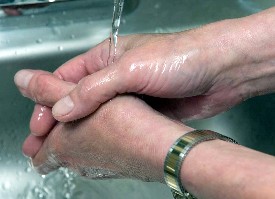Researchers at University of North Carolina at Chapel Hill find that an inexpensive set of infection control measures could save patient lives and cut health care costs by preventing hospital infections. The findings appear in the September 2011 issue of the journal Health Affairs (paid subscription required).
The Centers for Disease Control and Prevention estimate that 1 of every 20 hospital patients will acquire a health care associated infection. A 2009 CDC report calculates the direct costs to hospitals of these infections to range from $28 to $34 billion per year.
Bradford Harris, a professor at the UNC-Chapel Hill medical school and now a medical officer at the U.S. Food and Drug Administration, investigated ventilator associated pneumonias and central line associated bloodstream infections that occur when a catheter is passed through a vein to the large veins in the heart or the heart itself. The study, conducted by Harris and colleagues at an intensive care unit of North Carolina Children’s Hospital in Chapel Hill, tested three interventions aimed at preventing and reducing hospital acquired infections.
The first intervention enforced standard hand hygiene practices on the unit. All health care workers are expected to wash their hands with soap and running water or an alcohol-based rub on entering and leaving a patient’s room, before putting on and after removing gloves, and before and after any task that involves touching potentially contaminated surfaces or body fluids.
The second intervention implemented several measures to prevent ventilator-associated pneumonia. These measures include elevating the head of the patient’s bed while the patient is receiving breathing assistance from a ventilator, giving the patient daily breaks from sedation and then — while the patient was not sedated — assessing whether or not the patient is ready to come off the ventilator, and providing daily oral care such as teeth brushing and mouth washes with a long-lasting antiseptic.
The third intervention enforced guidelines for the use and maintenance of central-line catheters. The guidelines involve antiseptic-soaked sponges, catheters impregnated with antibiotics, and two assessments per day of the need for patients to continue the use of central-line catheters.
The costs of these measures are minimal: oral care kits cost $21 per day, and antiseptic patches and hand sanitizers cost about $0.60 per day. Patients admitted after the unit took these steps, however, spent 2.3 fewer days in the hospital, their hospital stays cost more than $12,000 less, and the rate of patient death was cut 2.3 percentage points, compared to patients admitted before the interventions.
Harris and colleagues estimated that adopting the three interventions together could save this single hospital unit some $12 million a year. If replicated nationwide, these measures potentially could save thousands of lives and billions of dollars each year.
Read more:
- CDC Awards Grants to Reduce Health Care Infections
- Noisy ORs Associated with Infections After Surgery
* * *


 RSS - Posts
RSS - Posts
[…] Read More: Study: Inexpensive Controls Cut Hospital Infections […]